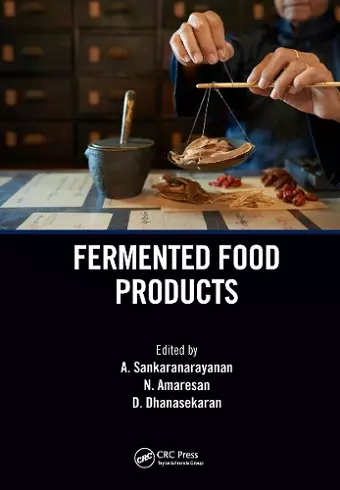Fermented Food Products
N Amaresan editor A Sankaranarayanan editor D Dhanasekaran editor
Format:Hardback
Publisher:Taylor & Francis Ltd
Published:9th Dec '19
Currently unavailable, and unfortunately no date known when it will be back

Fermented food play an important proactive role in the human diet. In many developing and under developed countries, fermented food is a cheap source of nutrition. Currently, more than 3500 different fermented foods are consumed by humans throughout the world; many are indigenous and produced in small quantities, however, the consumption of many fermented foods has gradually increased. Fermented Food Products presents in-depth insights into various microbes involved in the production of fermented foods throughout the world. It also focuses on recent developments in the fermented food microbiology field along with biochemical changes that are happening during the fermentation process.
• Describes various fermented food products, especially indigenous products
• Presents health benefits of fermented food products
• Explains mechans involved in the production of fermented foods
• Discusses molecular tools and its applications and therapeutic uses of fermented foods
The book provides a comprehensive account about diversified ethnic fermented food products. Readers will get updated information regarding various types of fermented food products and will learn the effect these fermented food products have on human health.
Fermented foods are very good for health and they have particular value, too, in being sources of nutrition that can be preserved for later consumption. This book makes a global contribution to the literature on fermented foods. Authors from many different countries present information from their local experience and research. The book's 23 chapters are contributed by 55 authors. While editors Sankaranarayanan and Amaresan (both, Uka Tarsadia Univ.) as well as Dhanasekaran (Bharathidasan Univ.) are all from India, contributing authors also hail from Brazil, Greece, Indonesia, Italy, Korea, Nigeria, Portugal, and Turkey. Many chapters include information on multiple fermented foods. Dairy products include amasi, borhani, cheese, dahi, kefir, rob, viili, and yogurt. Amasi is produced in Zimbabwe, while borhani is from Bangladesh. Rob is from Sudan and viili is found in Finland. Substrates for fermentation include cereals such as maize, millet, rice, sorghum, and wheat. Vegetables used include beets, cabbage, carrots, cauliflower, and cucumber, as well as eggplant, onion, and turnip. Fruits documented include durian, grapes, olives, and peaches. Tahiti and Taiwan are examples of island countries whose preserved foods are included. The book is written for readers who have an interest in fermentation processes and some background in foods. The useful index and many good references are an added attraction.
--L. E. Erickson, emeritus, Kansas State University, Choice, 2020 Vol. 58 No. 4
ISBN: 9780367224226
Dimensions: unknown
Weight: 929g
430 pages